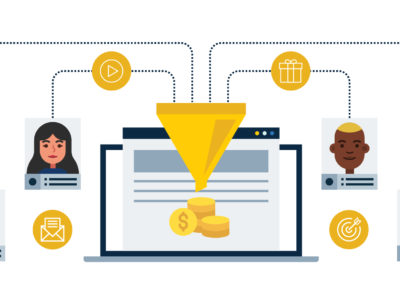Content Marketing is not just a hype anymore, it’s an important aspect of marketing and business operations, most specifically for B2B organizations. According to CMI’s benchmark report for 2016, 89% of B2B organizations implement Content Marketing, and 62% of these B2B marketers claim that their efforts are more successful than a year ago.
Content Marketing benefits a company’s marketing goals in a myriad of ways—it improves SEO, increases social media visibility, establishes your company as an industry leader, builds a community around your brand, among others.
But more importantly, Content Marketing ushers potential clients through your marketing funnel, eventually converting them to paying customers. That said, Lead Generation is very important to B2B organizations. In fact, 80% of all surveyed B2B marketers claim that Lead Generation is their top content marketing goal.
It’s important to note that you don’t just want any kind of leads, you want targeted leads. There’s no point in gaining a thousand email addresses of people who are not highly invested or interested in your subject of expertise. You’d rather have a few dozen email addresses from the right people.
So how do we create a Content Marketing Strategy that will bring in targeted leads?
1. Know your buyer personas very well
Knowing your target market is one of the most important steps in establishing any marketing strategy, or any business for that matter. In fact, how well you know your buyer persona will make or break your marketing strategy.
Who are these people, where can you find them, what are their problems, and how can you help?
You have to keep these buyer personas in consideration AT ALL TIMES, so make sure you have their profiles handy as you go about your Content and Lead Generation strategies.
{{cta(‘aa3d4773-1830-4c20-bf1b-e0aacd7526fb’)}}
2. Identify your long-tailed keywords
We like using Google Keyword Planner and Keywordtool.io when we’re putting together an intensive Keyword Analysis for our clients, especially for the purpose of SEO and PPC. But for the purpose of brainstorming content ideas, dare I say, try skipping the keyword tool once in a while!
I have a pretty easy approach on keyword research, mostly because I believe that as we create content, semantic keywords and related key phrases will naturally come out. After all, we’ve always talked about how to create content in the most natural way possible, with users and not search engines in mind.
Besides, if you’re a “digital marketing agency in the UK” who offers “content marketing services” or “keyword research and analysis” (insert your own products and services), I think you don’t need to know those keywords’ monthly search count to know that you absolutely need to create content for these key phrases!
So instead of logging in your Keyword Planner first out of habit, I suggest simply listing down your company’s niche, product, or services, and then running these key phrases through Google.
Google Related Search
It’s always good to see which big players are dominating the SERPs for your target keywords, so go ahead and quickly skim through the top 10 results.
For example, I want to find new trends on keyword research so I simply Googled “keyword research 2017”, and the top pages on keyword research comes up:
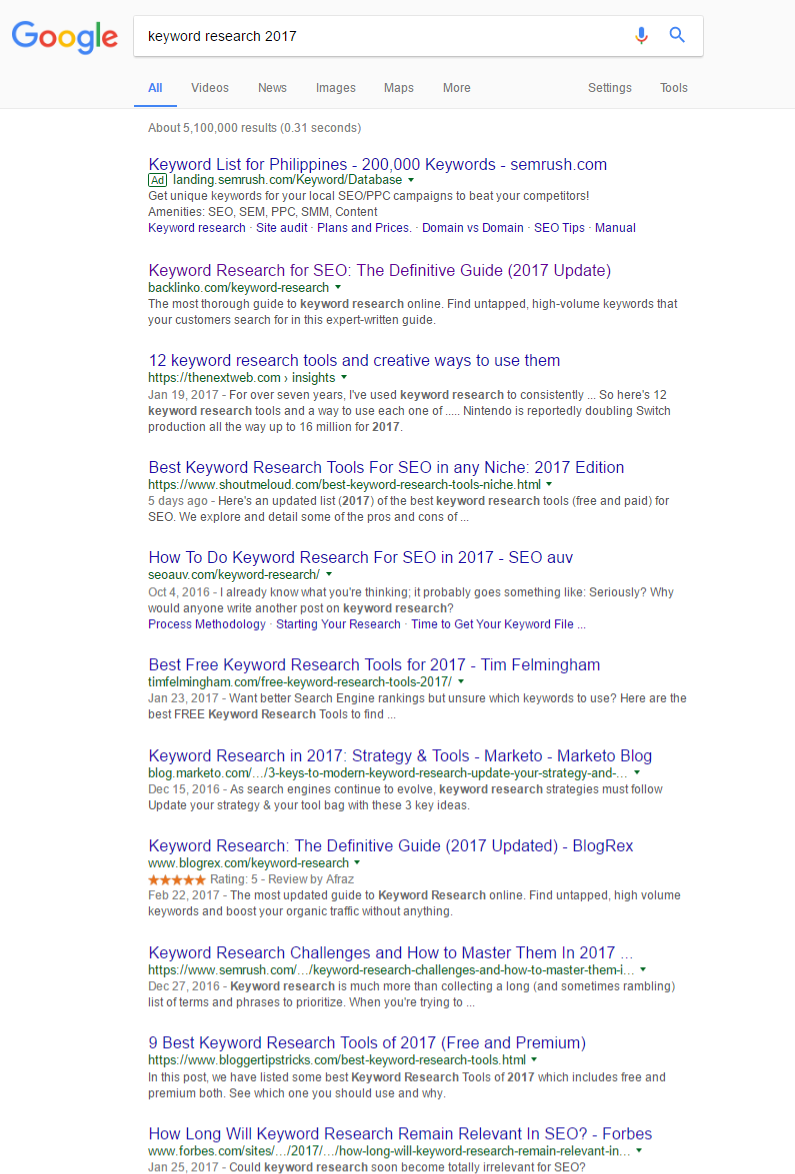
But as you scroll down to the bottom of the page, you’ll notice a list of related searches:
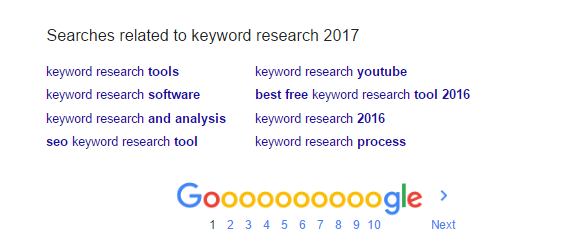
This list is a gold mine of content ideas you want to have on your pages; in fact, it reflects some of the long-tailed keywords you’ll see in the Google Keyword Planner. List down the key phrases that are relevant to your goals and be on your way.
If you want to dig deeper, click on one of those related keywords to take you to the corresponding result page, and yet another list of related results.
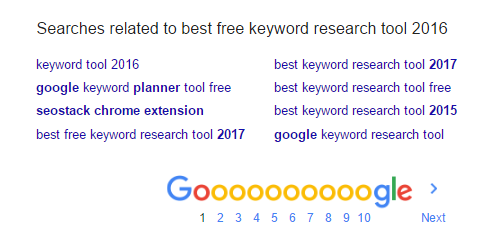 Through this simple approach, you don’t have to sift through thousands of keywords that are most likely not relevant to what you’ve set forth to do anyway.
Through this simple approach, you don’t have to sift through thousands of keywords that are most likely not relevant to what you’ve set forth to do anyway.
3. Identify your buyer persona’s frequently asked questions
The most effective types of content are the ones that answers questions and provides solutions. This is exactly the content you want to create if you want to attract targeted leads.
Reddit and Quora
These two channels are some of the most prominent boards people go to ask questions and find answers. Which makes it a good tool to find frequently asked questions. It’s also a good place to find potential customers who are asking questions you can answer—of course the goal is to bring them to your site and to capture them as leads.
Bloomberry (Beta)
Bloomberry is a new tool by the same guys who created Buzzsumo. Yep, if Buzzsumo is an important part of your daily outreach, content process, or idea generation routine, you’ll most likely enjoy Bloomberry too.
What Bloomberry does is generate a list of the most popular questions asked by your target buyer. It gathers actual questions from consumers throughout the buyer journey, and puts them in a comprehensive list, organized by sub-topics.
Here’s an example query for the phrase “keyword research”
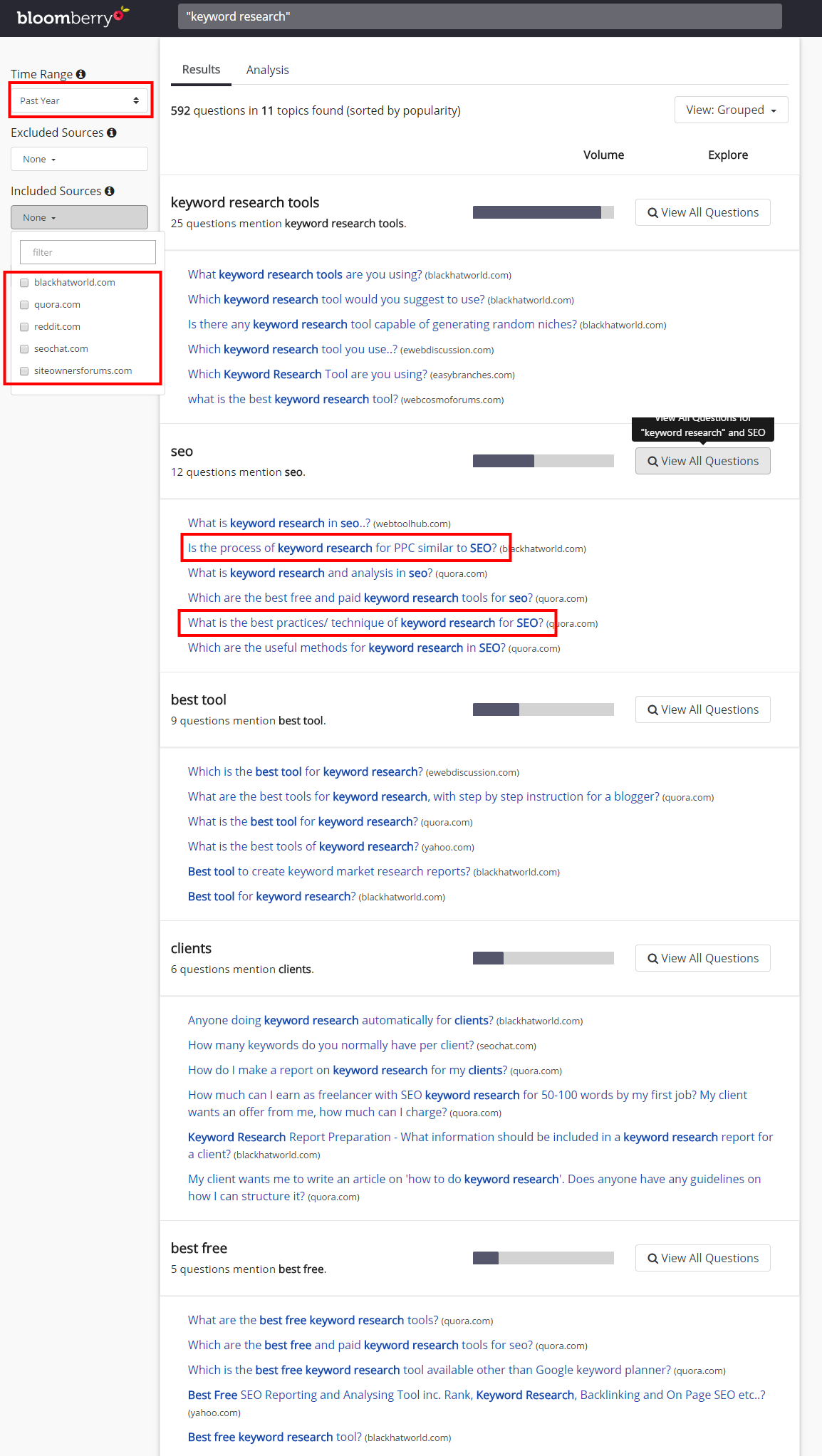
In this case, if you’re creating content about Keyword Research specifically to attract potential SEO or PPC clients, then take note of the questions within the “SEO” sub-group.
This list is quite a gem. You can filter out the results by Time Range, or include and exclude resources.
Notice that the questions are real questions asked by real consumers, generated from online forums and boards like Reddit, Quora, Amazon etc.
Bloomberry is currently on Beta. Jump in!
Answer the Public
This is one of my favorite tools lately. Answer the Public instinctively suggests questions based from keywords, much like Ubersuggest.org and Keywordtool.io, only better.
By adding interrogative words like “how”, “why”, “what”, “where” or prepositions like “for”, “with”, the tool is able to create more insightful content ideas, and puts together a nice visualization of the data like this:
 Pretty cool!
Pretty cool!
When coming up with keywords to focus on, it’s very important that you tackle long-tailed keywords in light of the questions and problems that your buyer persona might have.
What are his professional and business goals? What are the challenges he tackles on a daily basis? How can you make his job easier and more efficient? How can you help grow his business or achieve his targets?
Choose key phrases that are relevant to your business and highly targeted to your buyer persona’s needs and carefully plot these ideas in your inbound marketing funnel.
4. Create content for various stages of the funnel
When you’re satisfied with your list of keyword phrases and content ideas, it’s time to create content!
{{cta(’69bc7db2-eaf9-4a85-a552-fcc0c27d8d68′,’justifyright’)}}I have to say, the Content Creation Process is exactly as the term implies—it really is quite a process. Our Content Marketing Toolkit dives into the details of our content creation process, you can download it here if you like.
When creating content for the purpose of Lead Generation, it’s very important that you know exactly where it falls in the buyer’s journey.
Top of the Funnel (TOFU)
Top of the funnel content are content designed to attract visitors in the most basic sense to leave their email addresses.
Most of these leads won’t get your services or buy your product. But some of these leads can potentially be your next clients, you just have to know what kind of content to offer them.
That said, you don’t want to be to salesy at this point in the funnel. TOFU content should be informative and educational, maybe even entertaining. Imagine this as a way to establish rapport and capture interest.
Some of the usual TOFU content for B2B are the following:
- Blog posts
- Whitepapers
- E-Newsletter
- Ebooks
- Checklists
As they read your content, they should begin to identify and understand the problem, and why they need your solution. Your content should gain their trust enough for them to drop their email address in exchange for your content offer, turning them to a subscriber.
Middle of the Funnel (MOFU)
As the subscribers move down to the middle of the funnel, you should create content that will challenge them to solve the problem. At this point they’ve already figured out what they need and have started researching and finding solutions.
Your goal is to make them consider your product or service as the solution.
Some of the most effective MOFU content types are the following
- Processes
- Playbooks
- Webinars
Create a Playbook or a Guide that talks about your actual creative and technical processes to show them how you’ll tackle their requirements. This will push them further down the marketing funnel, and compel them to make a decision.
Bottom of the Funnel (BOFU)
The Bottom of the Funnel is like the final stretch before you hand the baton to your sales team. At this point your leads should be ready to make a decision, or at least curious enough to reach out and ask for a demo, a trial, or a Skype Call.
BOFU type of content is essentially your sales pitch.
- Demo
- Free Consultation
- Trial Period
- Video Call
More often than not, qualified leads will reach out to you when they’re ready. A free consultation or a skype call is a good way to get to know them in a personal level, giving you deeper insights into their unique circumstances. This will guide you in creating a sales deck that’s customize to their specific requirements.
5. Create lead capture pages or landing pages
Your landing page is the 6th person in your 5-man team who works 24/7 and collects email contacts on autopilot even while you’re asleep.
These days it’s not enough anymore that you drive traffic to your website through your blog content. You want these website visitors to have a name and a face–more specifically, an email address. This is how you can reach out to them later, and get them to keep coming back.
Landing pages for Content Offers are different from Sales Pages. A Sales Page might require more details about the product, social proof, and other creative gimmicks to convince leads to swipe their card.
A Content Offer, on the other hand, does not need too much fanfare, after all, you’re giving them free content. What’s important is that you make it very easy for them to leave their email address.
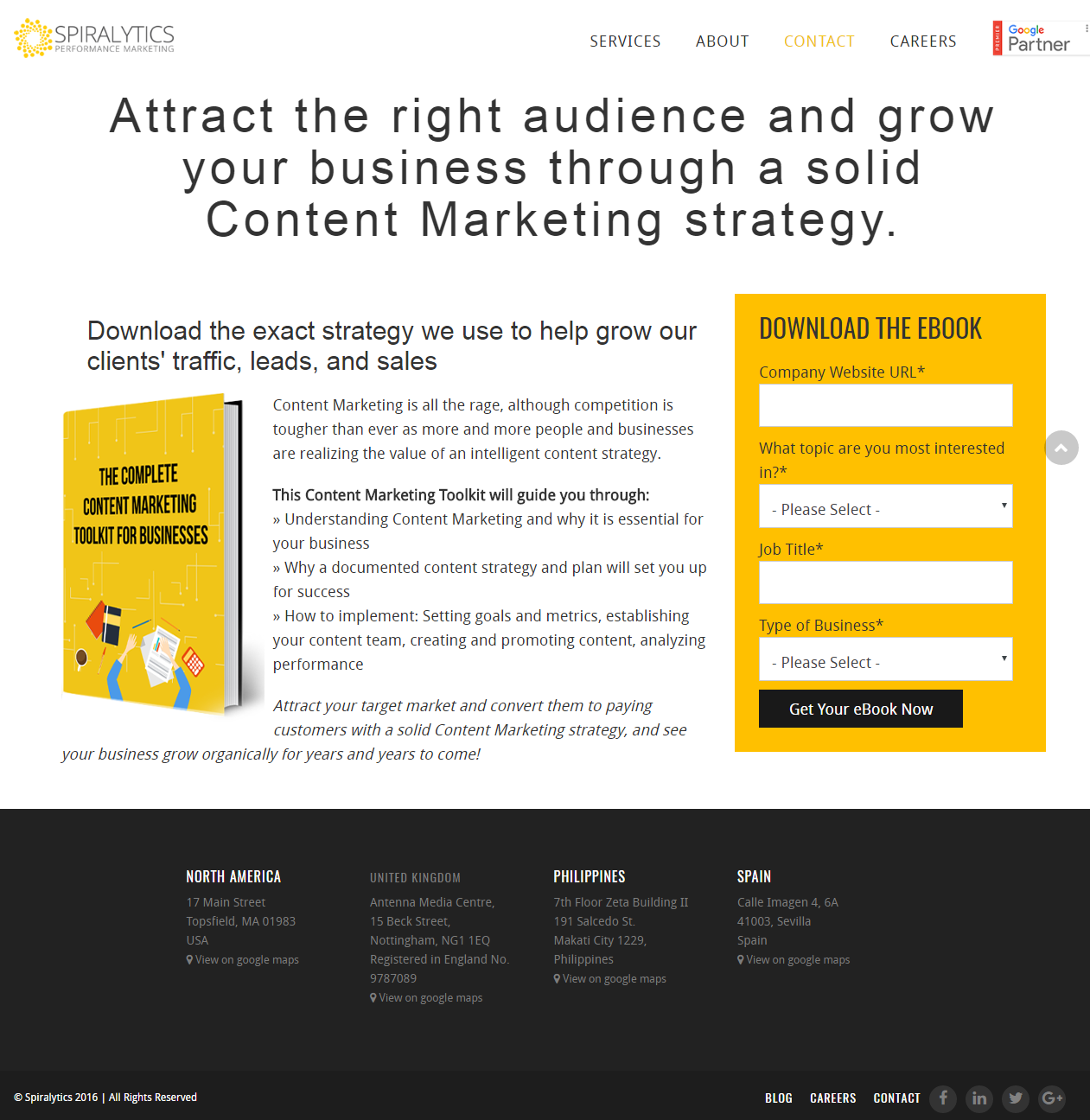
A good landing page for Content Offers should be simple, user-friendly, and straightforward.
It should have the following elements:
- A main headline and a supporting headline
- A unique selling proposition
- A straightforward description about what the content is about
- A single image, preferably a mockup of the content offer
- A sign up form
- A call to action
- A set of questions for you to profile them better, like the name of their company, their website, their job title
6. Analyze, Optimize, Scale
Once you have the landing pages, blog posts and content offers in place, it’s time to start promoting and tracking results.
The good thing about having a documented Content Marketing and Lead Generation strategy is that, when you find what works for you, you can simply repeat and scale the process.
The important thing is analyzing the effectiveness of each content you put out there, and knowing which metrics to focus on. What keywords brought you the most number of leads? Which blog post brought in the most number of ebook downloads? Which ebooks or case studies were effective in converting leads to sales?
Write more blog posts for those keywords. Publish more in-dept cases studies. Create more ebooks. Allow more people to find you, and woo them in with informative, valuable, and helpful content. Rinse, repeat.
{{cta(‘600a041e-e2d7-4435-8dde-b499b8c98dd9’)}}


